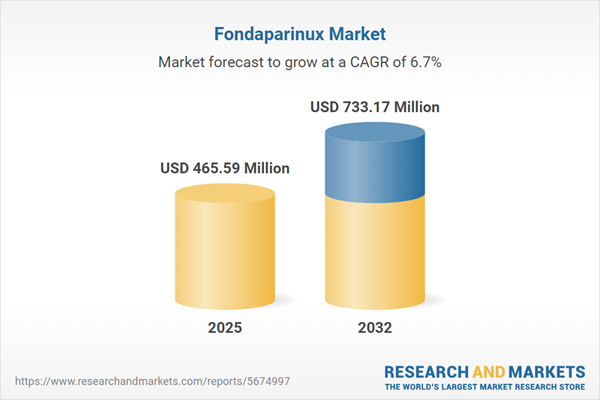Speak directly to the analyst to clarify any post sales queries you may have.
The Fondaparinux market is evolving rapidly, prompting senior executives to address changing demands in sourcing, digital adoption, and risk mitigation for value-driven healthcare delivery.
Market Snapshot: Fondaparinux Market Performance and Growth Drivers
Between 2024 and 2025, the global Fondaparinux market achieved robust growth, supported by increased use in hospitals and diverse care settings targeting vulnerable patient populations. This progress, reflected in a strong compound annual growth rate (CAGR), supports confident investment strategies among key manufacturers and institutional buyers. Ongoing uptake among healthcare providers has accelerated, underpinned by clinician reliance on Fondaparinux for effective thromboembolic management. Positive clinical outcomes and broad product accessibility have reinforced the market’s momentum, and regulatory responsiveness provides consistent value for stakeholders. These factors create an environment favorable to long-term portfolio expansion and sustainable performance through 2032.
Scope & Segmentation: In-Depth Insights for Decision-Makers
This report equips executive leaders with strategic intelligence for commercial and operational planning across the Fondaparinux market. Key areas covered include:
- Product Type: Comprehensive analysis of branded and generic Fondaparinux options highlights procurement strategies, workflow compatibility, and staff compliance considerations.
- Strength: Review of available dosage strengths explores their impact on acquisition planning and treatment protocol customization to align with varying patient needs.
- Distribution Channel: Assessment of hospital, retail, and online pharmacy models focuses on fulfillment efficiency, patient access, and supply chain reliability.
- End User: Examination of usage trends identifies adoption across hospitals, clinics, ambulatory surgical centers, and home-based care while addressing shifts in collaborative patient management.
- Indication: Evaluation of established clinical applications, such as acute coronary syndrome and venous thromboembolism prevention, considers emerging therapeutic potential for new clinical indications.
- Age Group: Uptake analysis spans adults, pediatric, and geriatric segments, emphasizing individualized care pathways and optimized clinical outcomes.
- Regions: Regional review provides focused analysis of markets in the Americas, EMEA, and Asia-Pacific, with in-depth coverage of local regulations, investment behaviors, and drivers in the United States, Germany, India, Brazil, and China.
- Leading Companies: Profiles for GlaxoSmithKline plc, Sandoz International GmbH, and Teva Pharmaceutical Industries Ltd examine innovation, market adaptability, and evolving positions within the sector.
Key Takeaways for Fondaparinux Market Leaders
- The stable pharmacokinetic characteristics of Fondaparinux facilitate efficient procurement and integration, promoting reliable care delivery across complex healthcare infrastructures.
- Segmented market analysis enables tailored anticoagulation solutions, advancing personalized medicine initiatives while optimizing patient care pathways and operational efficiency.
- The growing availability of generic Fondaparinux encourages suppliers to enhance clinical support offerings, deepening engagement with healthcare providers and fostering enduring partnerships.
- Regional differences in reimbursement and procurement require adaptable, locally nuanced commercial strategies to secure and protect market access.
- Digital technologies support improved monitoring, adherence, and collaboration among payers and healthcare teams, driving efficiency in care delivery and resource management.
- Maintaining effective collaboration between manufacturers and distributors is essential for operational continuity amid evolving regulatory and logistical landscapes.
Tariff Impact: United States Market Adaptation
Recent tariff changes in the United States have affected the Fondaparinux supply chain and procurement strategies across healthcare organizations. As a result, emphasis has shifted toward regional supplier selection to maintain cost control and inventory consistency. Enhanced collaboration between manufacturers and payers supports compliance and operational resilience in a changing regulatory framework.
Methodology & Data Sources
This analysis is based on direct engagement with clinical, supply chain, and executive decision-makers. Validation includes regulatory filings, peer-reviewed studies, and industry market intelligence, ensuring that findings align with the strategic requirements of senior leaders.
Why This Report Matters
- Supports executive teams in proactively managing regulatory updates and evolving market dynamics to strengthen organizational resilience.
- Provides portfolio and commercial leaders with benchmarking data and actionable insights, enabling enhanced differentiation and sustained performance.
- Prepares leadership for increased digital transformation and regulatory changes, ensuring business continuity and forward-looking strategies.
Conclusion
This Fondaparinux market report delivers actionable insights for executive teams, guiding strategic responses to industry changes and supporting long-term growth and operational resilience.
Additional Product Information:
- Purchase of this report includes 1 year online access with quarterly updates.
- This report can be updated on request. Please contact our Customer Experience team using the Ask a Question widget on our website.
Table of Contents
3. Executive Summary
4. Market Overview
7. Cumulative Impact of Artificial Intelligence 2025
Companies Mentioned
The companies profiled in this Fondaparinux market report include:- GlaxoSmithKline plc
- Sandoz International GmbH
- Teva Pharmaceutical Industries Ltd
- Mylan N.V.
- Dr. Reddy’s Laboratories Ltd
- Apotex Inc.
- Sun Pharmaceutical Industries Ltd
- Cipla Ltd
- Accord Healthcare Limited
- Aspen Pharmacare Holdings Limited
Table Information
| Report Attribute | Details |
|---|---|
| No. of Pages | 189 |
| Published | October 2025 |
| Forecast Period | 2025 - 2032 |
| Estimated Market Value ( USD | $ 465.59 Million |
| Forecasted Market Value ( USD | $ 733.17 Million |
| Compound Annual Growth Rate | 6.7% |
| Regions Covered | Global |
| No. of Companies Mentioned | 11 |









